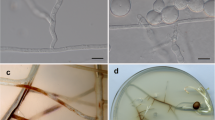Abstract
A chytridiaceous fungus was found parasitic in the roots of cucurbitaceous plants in Varanasi during December–March. Morphology and development of the vegetative and reproductive structures and its parasitism confined to the cucurbitaceous host plants as revealed by inoculation studies, indicated it as a variant isolate of Olpidium brassicae (Woronin) Dangeard. Association of the pathogen with mosaic virus-infected cucurbit vines indicated its possible role in the transmission of pumpkin and bottle gourd mosaic viruses.
Similar content being viewed by others
References
Barr, D.J.S. 1968. A new species of Olpidium parasitic on cucumber roots. Can. J. Botany 46: 1087–1091.
Cook, W.R.I. & W.B. Collins. 1935. The life history of Olpidium majus sp. nov. with notes on Olpidium radicale Schwartz and Cook. Ann. Mycol. 33: 72–78.
Couch, J.N. 1941. The structure and action of the cilia in some aquatic Phycomycetes. Am. J. Botany 28: 704–713.
Garrett, R.G. & J.A. Tomlinson. 1967. Isolate differences in Olpidium brassicae. Trans. Brit. Mycol. Soc. 50: 429–435.
Hiruki, C. 1965. Transmission of tobacco stunt virus by Olpidium brassicae. Virology 25: 541–549.
Sahtiyanci, S. 1961. Studien über einige würzel-parasitäre Olpidiaceen. Arch. Mikrobiol. 41: 187–228.
Sahtiyanci, S., A. Gaertner & W.H. Fuchs. 1960. Zur Morphologie von Olpidium brassicae (Wor.) Dang. Arch. Mikrobiol. 35: 379–383.
Singh, S.L. 1974. Studies on some diseases of cruciferous crops in Varanasi. Ph. D. Thesis, Banaras Hindu University, India. 177 p.
Singh, S.L. & M.S. Pavgi. 1975. Occurrence of Olpidium brassicae in India. Curr. Sci. 44: 89–91.
Singh, S.L. & M.S. Pavgi. 1977. Olpidium brassicae in the cabbage roots. Mycopathologia 62: 47–52.
Sparrow, F.K. 1960. Aquatic Phycomycetes. The Univ. Michigan Press, Ann Arbor, Michigan. 1187 p.
Teakle, D.S. 1960. Association of Olpidium brassicae and tobacco necrosis virus. Nature, Lond. 188: 431–432.
Tomlinson, J.A. & R.G. Garrett. 1962. Role of Olpidium in the transmission of big-vein of lettuce. Nature, Lond. 194: 249–250.
Tomlinson, J.A. & R.G. Garrett. 1964. Studies on the lettuce big-vein virus and its vector Olpidium brassicae (Wor.) Dang. Ann. Appl. Biol. 54: 45–61.
Author information
Authors and Affiliations
Rights and permissions
About this article
Cite this article
Raghavendra Rao, N.N., Pavgi, M.S. Olpidium species parasitic in the roots of cucurbitaceous plants. Mycopathologia 71, 149–154 (1980). https://doi.org/10.1007/BF00473062
Issue Date:
DOI: https://doi.org/10.1007/BF00473062




